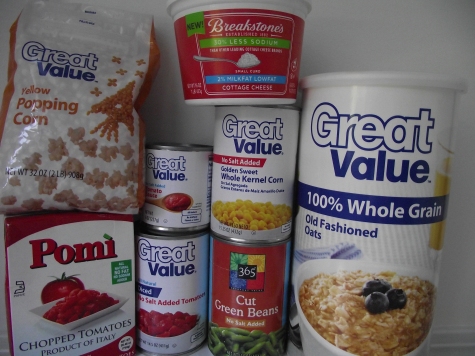
This week is World Salt Awareness Week – how exciting!? I know it’s already Thursday, but salt awareness is pretty important. Kind of boring – yes, but still very important. Even though salt is an important mineral that our body needs, most Americans consume way too much salt. So here are some quick facts about salt intake…
Some of the causes too much salt can have on your health:
- heart disease – including congestive heart failure and strokes!
- bloating
- high blood pressure
- osteoporosis
- kidney problems
- and more
Sneaky and obvious sources of sodium/salt {I use these words interchangeably} that you should watch out for in the grocery store:
- Chicken Breasts – look at the nutrition facts label. Any chicken with added solution, salt, broth, or marinades with likely have a high sodium content. Chicken naturally has very little sodium, so avoid chicken that has anything over 75mg sodium per serving. Be careful because “all-natural” chicken can still have high sodium since the added chicken broth or salt is natural.
- Processed meats – most sandwich meats, sausage, bacon, etc. have a lot of sodium. “Smoky” usually means it is higher in sodium than its regular version. Look for uncured, reduced-sodium bacon & sausage.
- Packaged Oatmeal – make your own oatmeal instead of buying the packaged oatmeal because it usually has a lot of added sodium (along with added sugar and other things). Or if you must buy flavored oatmeal packets, look for low-sodium versions like Quaker Simple Harvest Multigrain Hot Cereal or Kashi Hot Cereals.
- Reduced-fat peanut butter – something has to replace the fat that is normally found in peanuts. When they take out some of the fat, they replace it with salt and sugar. Reduced-fat peanut butter is definitely something you should avoid, especially because peanut butter contains healthy fat. Be sure to buy the natural or simply peanut butter instead of the kind with added oils, hydrogenated oils, or sugar.
- Canned tomatoes, salsa, tomato sauce – look for no-salt added tomato products. Read the ingredients list and buy products that list only tomatoes as their ingredients
- Other canned foods:
- Soups and broths/stocks – look for reduced sodium products. Try to find low-sodium or no-salt added broths and stocks; that way you can control the sodium and add just the amount of salt you want. When eating canned soups, stick to one serving size; most cans contain 2 servings and will give you almost half of the amount of sodium you should have in one day.
- Beans – look for reduced-sodium or no salt added beans. Be sure to rinse the beans well to reduce some of the sodium content.
- Vegetables – same as for beans: buy no-salt added canned vegetables and rinse before using {if needed, add plain water back to can}
- Snack foods:
- Pretzels – just one serving of mini pretzel twists has almost 20% of the recommended limit for sodium a day! Try to buy lower sodium snacks like low-salt crackers, lightly or unsalted nuts, or unsalted popcorn (you can add a little salt yourself).
- Cheese – usually has a lot of sodium so look for reduced-sodium brands, and try to use less cheese in cooking. Swiss commonly has less sodium than other cheeses but double-check.
- Packaged products:
- Rice, pasta, bread crumbs or other pre-seasoned foods are usually full of sodium! Avoid these products if possible.
- Frozen meals & pizzas – almost all frozen meals have way too much sodium for one meal. Frozen meals can be helpful for portion control and for a quick & easy meal, but try not to eat them more than a couple of times per week. Be sure to add extra vegetables or fruit to the meal, too.
- Condiments:
- Salad dressing – your best bet is to make your own because even healthier versions of salad dressings usually have over 350mg sodium (15% of daily limit) in just 2 tablespoons.
- Ketchup – very few people stick to the 1 TBSP serving size of ketchup, so its sodium content adds up. Either buy the salt free ketchup or use less.
- Salsa – check labels {I sound like a broken record!} Newman’s Own Salsa has less than most store brands and other popular salsa brands.
- Sauces: soy sauce, BBQ sauce, hot sauce – all of these sauces typically have a lot of sodium in them. Soy sauce is the highest, and while the lower-sodium/lite version does have less, it still has a lot for a small serving. Just because it says “lower-sodium” on it doesn’t mean you can use an unlimited amount. For other sauces, just try to find the product with the lowest amount of sodium compared to other versions and use it sparingly.
Try using salt free seasonings & condiments instead of pouring or dipping your food into sodium filled flavorings. When cooking or marinating, use salt free marinades or make your own with oil & vinegar + fresh herbs and garlic. Season food with fresh herbs, spices, and salt-free spice blends. Eating less pre-packaged food, fast food, and meals from restaurants will help you significantly save on sodium intake!
The moral of the story is that you really need to read food labels. Reading labels and ingredients lists are the best ways to determine how much salt a food contains. Foods that don’t typically have a label like fruits & vegetables are usually sodium free or have very low sodium. Frozen fruits and vegetables are good options as well, but be sure to buy products without added salt, sugar, or sauces.
And now you know all about salt 🙂


Wheeler
April 2, 2012
Meme, you’re killing me with the pretzels!!! 😦
memeinge
April 4, 2012
haha I know! Sarry!!